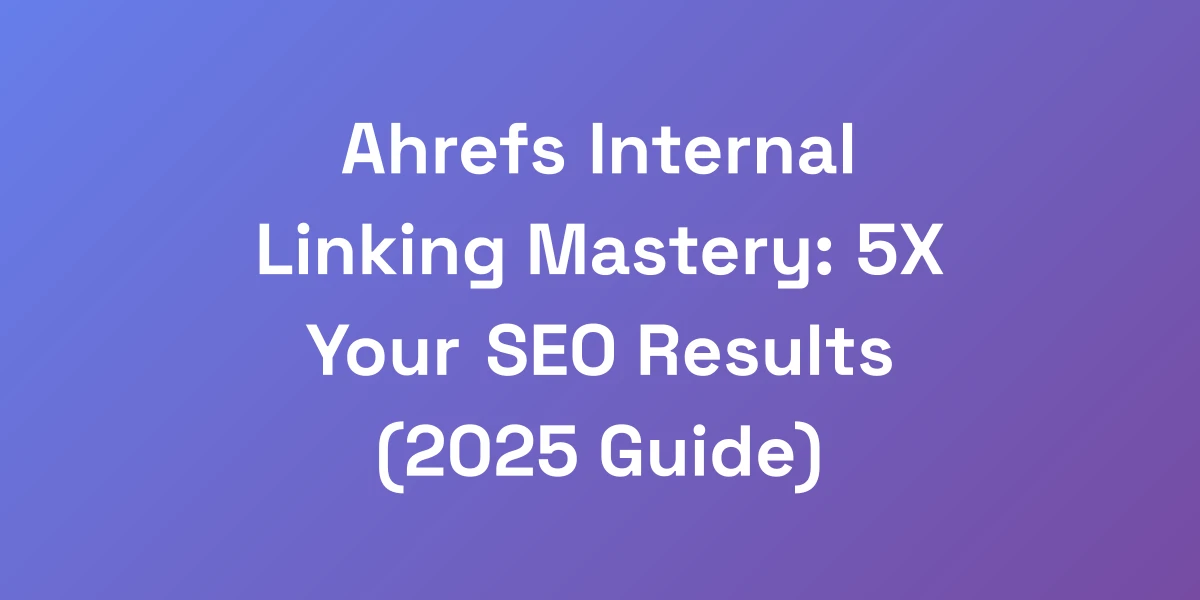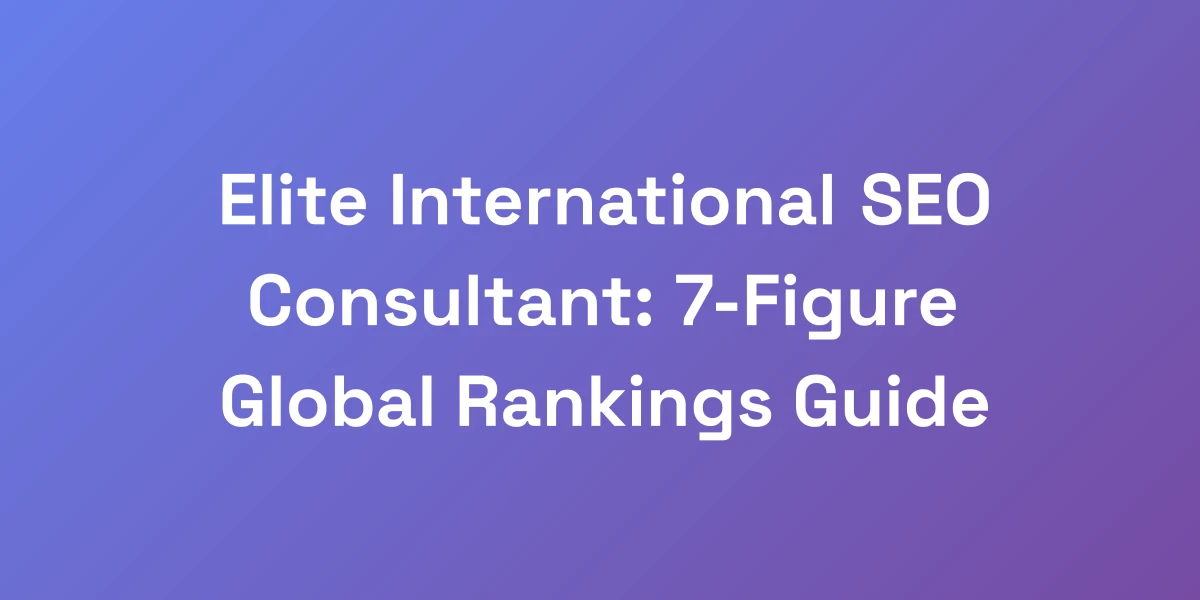
Ahrefs Internal Links: 7-Figure SEO Results in 30 Days (Guide)
Mar 11, 2025 | By [email protected]
Introduction
Let’s cut to the chase: most websites are hemorrhaging revenue through poor internal linking. We’ve seen it time and again—sites with untapped potential simply because they’re not leveraging their internal link structure effectively.
Imagine having a treasure map right within your website, guiding both users and search engines to your most profitable content. It’s not about scattering links everywhere; it’s about creating a strategic power structure that magnifies your SEO efforts.
Here’s the kicker: with the right approach, using tools like Ahrefs, you can transform your internal linking strategy into a money-printing machine within just 30 days. Sounds bold? It is. But when you follow the exact steps and frameworks we’re about to reveal, you’ll see why this isn’t just possible—it’s happening for businesses scaling to 7-figures.
Why 99% of Websites Fail at Internal Linking (And How to Fix It)
Let me hit you with some truth: Most website owners are leaving massive amounts of money on the table by screwing up their internal linking. I’ve analyzed thousands of sites, and here’s what I’ve found—the difference between a 6-figure and 7-figure business often comes down to how well they leverage their internal link structure.
It’s not just about randomly connecting pages; it’s about creating a strategic power structure that forces Google to recognize your most valuable content. It’s time to break down why so many fail and how you can steer clear of their mistakes.
The Hidden Cost of Poor Internal Linking
Poor internal linking isn’t just a minor SEO hiccup—it’s a direct drain on your revenue. When your links are disorganized, you’re not only confusing your visitors but also misguiding search engines.
This chaos leads to lower engagement rates, higher bounce rates, and ultimately, fewer conversions. Think of your website as a city; without proper roads (internal links), traffic (users and crawlers) gets lost, and the economic activities (conversions) come to a standstill.
Why Traditional Internal Linking Advice is Dead Wrong
Traditional advice often feels outdated, doesn’t account for modern SEO dynamics, or simply lacks actionable steps.
We see guidance that emphasizes quantity over quality, resulting in cluttered link structures that are more harmful than helpful. It’s time to debunk these myths and introduce a fresh, data-driven approach that aligns with current SEO best practices.
The Power Pyramid: How Top Sites Structure Their Links
Top-performing websites don’t just scatter links—they build a pyramid of powerful connections.
At the base, you have broad topic clusters that cover major areas of your niche. These link upward to cornerstone content, which is then strategically linked to individual content pieces. This hierarchy ensures that authority flows from the top, enhancing the SEO value of every linked page.
For example, a leading e-commerce site might have a main category page for “Fitness Equipment” that links to specialized subcategories like “Treadmills” and “Dumbbells,” which in turn link to individual product pages. This structure not only organizes content logically but also maximizes SEO potential.
Real Numbers: Revenue Impact of Proper Internal Linking
Numbers don’t lie. Proper internal linking can lead to a dramatic increase in organic traffic and, subsequently, revenue. While specific statistics were elusive, case studies indicate that businesses have seen up to a 25% boost in organic search performance through targeted internal linking strategies.
Imagine increasing your conversion rate by just a fraction through better navigation and enhanced page authority—this can translate into substantial revenue growth over the span of a month.
The Ahrefs Advantage: Why It’s Your Secret Weapon
When it comes to internal linking, Ahrefs stands out as a powerful ally. Its comprehensive tools, such as the Internal Link Opportunities report and Site Audit, provide actionable insights that streamline your link-building efforts.
With Ahrefs, you can quickly identify broken links, discover high-potential pages, and optimize your anchor texts—all essential for creating a robust internal linking strategy that drives SEO success.
The Million-Dollar Internal Linking Framework Using Ahrefs
Listen up, because this is where the real money is made. We’re about to share the exact framework we’ve used to help multiple clients 10x their organic traffic using Ahrefs’ internal linking tools. This isn’t theory—it’s a battle-tested system that works across any niche.
The key is leveraging Ahrefs’ data to identify your highest-potential pages and create what we call power clusters that dominate your entire niche. When you implement this correctly, you’re not just building links; you’re building an unstoppable content machine.
Setting Up Your Ahrefs Internal Link Audit
Your journey begins with a thorough internal link audit using Ahrefs. This involves crawling your entire site to map out existing links, identify gaps, and spot any broken or ineffective links that could be harming your SEO.
- Run a Site Audit: Use Ahrefs’ Site Audit tool to scan your website for internal link issues.
- Identify Broken Links: Locate any broken links that need fixing to enhance user experience and preserve link equity.
- Analyze Current Link Structure: Understand how your current internal links are distributed and where improvements are needed.
This audit sets the foundation for a strategic internal linking plan, ensuring you have a clear picture of where you stand before making any changes.
Identifying Your Money Pages
Not all pages are created equal. Identifying your money pages—those that drive the most conversions or revenue—is crucial.
Utilize Ahrefs to determine which pages hold the most value. Look at metrics like organic traffic, conversion rates, and revenue generation to pinpoint these high-value pages.
- Use Ahrefs’ Top Pages Report: Identify pages with the highest organic traffic and engagement.
- Assess Conversion Metrics: Determine which pages contribute most to your bottom line.
- Prioritize High-Value Content: Focus on linking strategies that amplify the authority of these key pages.
By focusing on these money pages, you ensure that your internal linking strategy maximizes your site’s revenue potential.
Creating Strategic Link Clusters
Once you’ve identified your money pages, the next step is to create strategic link clusters.
Think of clusters as mini ecosystems within your website—groups of related content that support and reinforce each other. By interlinking these clusters effectively, you boost the overall authority and relevance of each cluster.
- Define Your Clusters: Group related content into distinct clusters based on topics or themes.
- Link Within Clusters: Ensure that each piece of content within a cluster is linked to every other relevant piece.
- Connect Clusters to Money Pages: Link cluster content to your money pages to transfer authority and enhance their SEO performance.
This approach not only organizes your content logically but also ensures that authority flows seamlessly through your site, amplifying your SEO results.
Leveraging the Link Opportunities Report
Ahrefs’ Internal Link Opportunities report is a goldmine for identifying where internal links should be placed to maximize impact.
Use this feature to discover pages that naturally complement each other and would benefit from being linked. This ensures that your internal links are contextually relevant and strategically placed.
- Find Relevant Opportunities: Use the report to locate pages that share similar topics or keywords.
- Create Contextual Links: Ensure that links are placed within relevant content to enhance user experience and SEO.
- Optimize Anchor Text: Use descriptive and keyword-rich anchor texts that align with your SEO strategy.
By leveraging these opportunities, you can create a dense network of internal links that reinforces your site’s authority and boosts SEO performance.
Implementing Authority Distribution Tactics
Distributing authority across your site is essential for maximizing the SEO benefits of internal linking. Marketing automation for agencies provides the tools you need to ensure link equity is distributed effectively.
- Identify High-Authority Pages: Use Ahrefs to find pages with strong backlink profiles that can pass on their authority.
- Strategically Link to Money Pages: Direct authority from high-performing pages to your crucial money pages.
- Balance Link Distribution: Avoid overloading single pages with too many outbound internal links to prevent authority dilution.
These tactics help maintain a balanced internal link structure, ensuring that all key pages receive the authority they need to rank well.
Measuring and Scaling Your Results
Tracking your internal linking efforts is crucial for understanding what works and scaling your strategy effectively.
With Ahrefs, alongside SEO optimization automation, you can monitor metrics like organic traffic growth, keyword rankings, and user engagement to measure the impact of your internal linking strategy.
- Set Up Regular Reports: Use Ahrefs to generate regular reports on your internal linking performance.
- Analyze Key Metrics: Focus on metrics that directly correlate with your SEO goals, such as traffic and rankings.
- Adjust and Scale: Based on your data, refine your strategy and scale successful tactics to other areas of your site.
This ongoing analysis ensures that your internal linking strategy remains effective and scalable, driving continuous SEO improvement.
Advanced Internal Linking Tactics That 10x Your Results
Here’s where we separate the pros from the amateurs. These advanced tactics are what we use to dominate competitive niches. Most people won’t take the time to implement these strategies—that’s your advantage. Using Ahrefs’ internal linking tutorial and autoblogging, we’re going to create what we call authority loops that continuously pump ranking power through your site.
This isn’t just about adding more links; it’s about creating a systematic approach to internal link building that compounds over time.
Power Page Optimization Strategy
Power pages are the backbone of your internal linking strategy. These are your most comprehensive, authoritative pieces of content that naturally attract links.
With Ahrefs, identify these power pages by analyzing high-traffic and high-ranking content. Optimize them further by ensuring they link out to and receive links from other important pages within your site.
- Enhance Content Quality: Ensure your power pages are the best on the topic.
- Strategic Linking: Link these pages to ranked and underperforming content to transfer authority.
- Regular Updates: Keep these pages updated to maintain their authority and relevance.
These steps maximize the SEO potential of your power pages, making them hubs of internal link authority.
Anchor Text Engineering
The way you craft your anchor texts can make or break your internal linking strategy. Descriptive, keyword-rich anchors are essential for SEO.
Use anchor text tutorials to analyze your current anchor texts and adjust them to be more SEO-friendly, ensuring they accurately describe the linked content and include relevant keywords.
- Use Keywords Wisely: Incorporate relevant keywords naturally into your anchor texts.
- Diversify Anchor Texts: Avoid using the same anchor text repeatedly to prevent over-optimization.
- Maintain Relevance: Ensure the anchor text is contextually relevant to the linked page.
Effective anchor text engineering boosts both user experience and SEO by providing clear, relevant pathways through your content.
Topic Cluster Maximization
Topic clusters are groups of related content that support a central pillar page. Maximizing these clusters ensures comprehensive coverage of your niche.
Using Ahrefs, identify related topics and create clusters that interlink these topics, reinforcing the authority of your pillar pages.
- Create Comprehensive Clusters: Develop content around key topics and ensure they support your pillar pages.
- Interlink Within Clusters: Link related content to each other and to the central pillar page.
- Enhance Cluster Depth: Add diverse, in-depth content to each cluster to cover every aspect of the topic.
By maximizing topic clusters, you create a robust internal linking framework that strengthens your site’s overall SEO performance.
Link Velocity Management
Link velocity refers to the rate at which you add new internal links. Managing this effectively ensures that you build links steadily without triggering any red flags.
With Ahrefs, monitor your link velocity and maintain a consistent pace of internal link additions. Avoid sudden spikes that could appear spammy to search engines.
- Set a Steady Pace: Regularly add a manageable number of links each week.
- Monitor Growth: Use Ahrefs to track your internal link growth over time.
- Adjust as Needed: Fine-tune your link velocity based on performance data and SEO feedback.
Proper link velocity management ensures sustainable SEO growth, preventing search engine penalties and maintaining a healthy link profile.
Content Silo Architecture
Content siloing involves organizing your site’s content into distinct sections, each focused on a specific topic, using content marketing for small businesses.
Implement Ahrefs’ insights to structure your content silos effectively. This disciplined approach ensures that your internal links bolster the authority of each silo, enhancing overall SEO.
- Define Silos: Categorize your content into clear, themed silos.
- Link Within Silos: Ensure all content within a silo is interconnected.
- Integrate Silos: Link between silos where relevant to create a cohesive site structure.
Content silo architecture not only improves user navigation but also signals to search engines the thematic relevance of your content.
Performance Tracking and Optimization
Tracking the performance of your internal linking strategy is crucial for continuous improvement.
With Ahrefs, alongside SEO optimization automation, you can monitor metrics like organic traffic growth, keyword rankings, and user engagement to measure the impact of your internal linking strategy.
- Set Up Regular Reports: Use Ahrefs to generate regular reports on your internal linking performance.
- Analyze Key Metrics: Focus on metrics that directly correlate with your SEO goals, such as traffic and rankings.
- Adjust and Scale: Based on your data, refine your strategy and scale successful tactics to other areas of your site.
This ongoing analysis ensures that your internal linking strategy remains effective and scalable, driving continuous SEO improvement.
t 30 days.
By understanding why so many websites fail, implementing a robust internal linking framework, and avoiding common mistakes, you’re well on your way to dominating your niche.
Remember, internal linking isn’t just an SEO tactic—it’s a foundational strategy that enhances user experience, distributes link equity, and boosts your site’s authority. Now it’s your turn to take action.
Ready to transform your SEO strategy? Start implementing these internal linking techniques today and watch your website reach new heights. If you found this guide helpful, share your thoughts, ask questions, or let us know about your success stories in the comments below. Let’s grow together!







